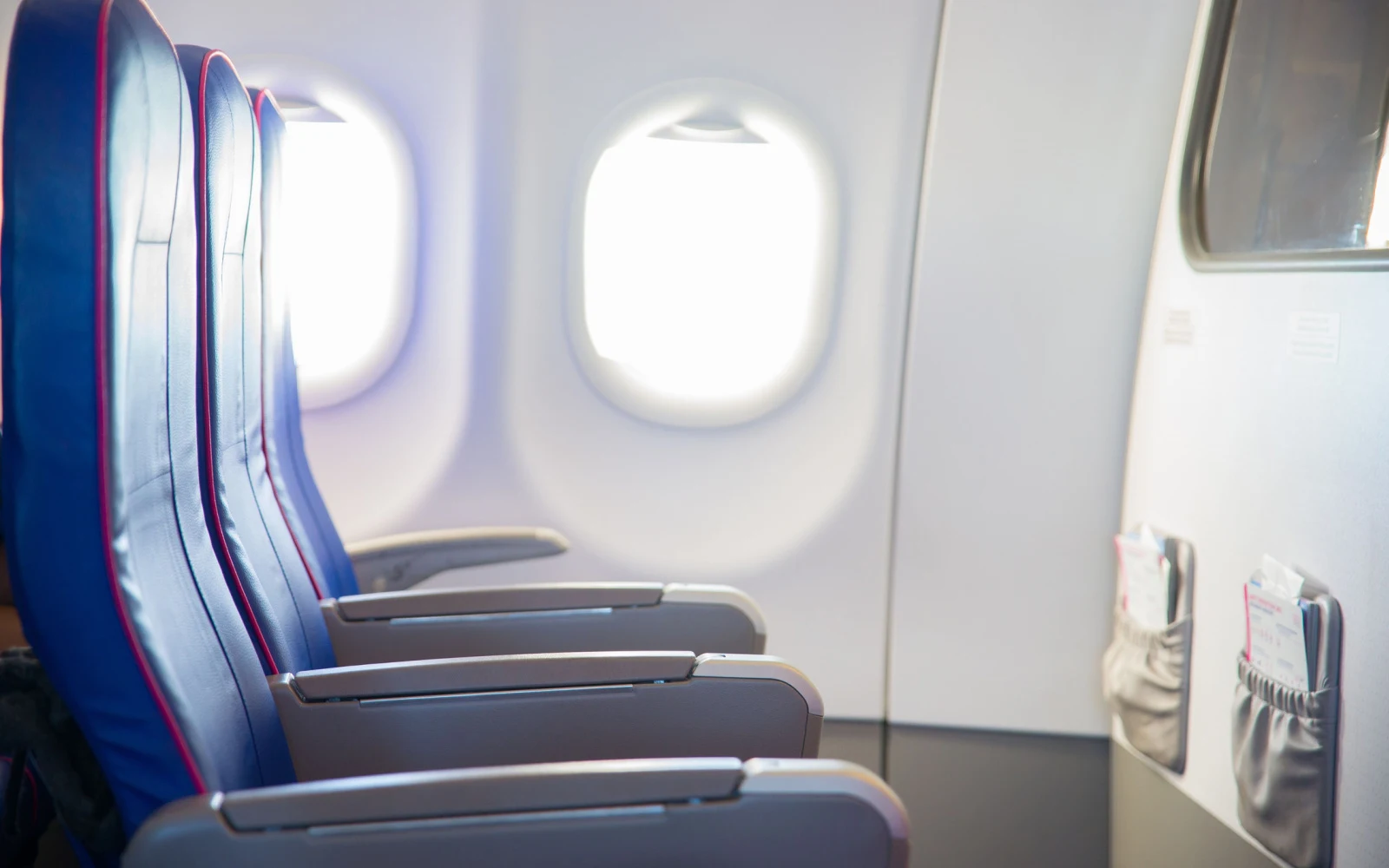What is a bulkhead seat on a plane?
A bulkhead seat is located behind a plane’s bulkhead, the wall dividing cabin classes or sections, and can differ in experience based on whether it’s a physical wall or a curtain partition. Pros include potential extra legroom, easy access to restrooms or galleys, and for parents, the option for bassinet brackets; cons include no under-seat storage, possibly restricted legroom, and proximity to high-traffic areas.
What Is a Bulkhead Seat?
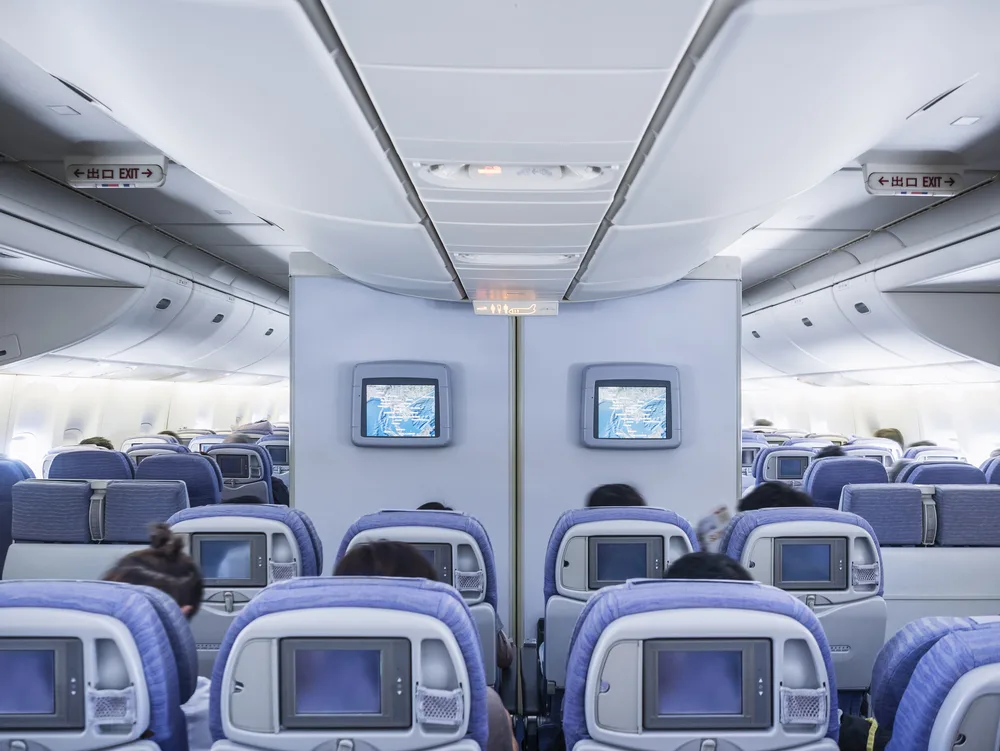
VTT Studio/Shutterstock
Bulkhead seats are different because they’re behind a wall instead of another row of seats. Larger planes may have multiple bulkheads, resulting in more than one bulkhead seating area.
For example, you might sit in the first class bulkhead, business class bulkhead, or economy/economy plus bulkhead. The bulkhead itself can be a physical wall, with or without footwell cutouts, or it can be a sliding curtain partition that visually divides the sections of the plane.
There are pros and cons associated with bulkhead seats. Some people consider them some of the best seats on the plane while others avoid bulkhead seats at all costs.
The presence of a physical wall (especially without footwell cutouts) versus a sliding curtain makes a big difference in the experience of sitting in a bulkhead seat – it can mean you have very little legroom or more legroom than other passengers.
We’ll explore what a bulkhead seat is, the pros and cons of choosing them, and how to determine whether or not you’ll appreciate sitting in a bulkhead seat next in this guide.
Bulkhead Seat Pros and Cons
When you ask “What is a bulkhead seat?” you’re probably looking for an honest list of the pros and cons. The truth is that bulkhead seating has a lot of benefits and drawbacks.
Bulkhead seats can catch a bad rap among frequent flyers, but there are actually several upsides to sitting in this area of the plane. For some travelers, they’re the best seats on the plane.
But bulkhead seats are not without their cons. In fact, some passengers flat-out refuse to fly in the bulkhead row because of the drawbacks associated with these seats.
Bulkhead Seat Pros
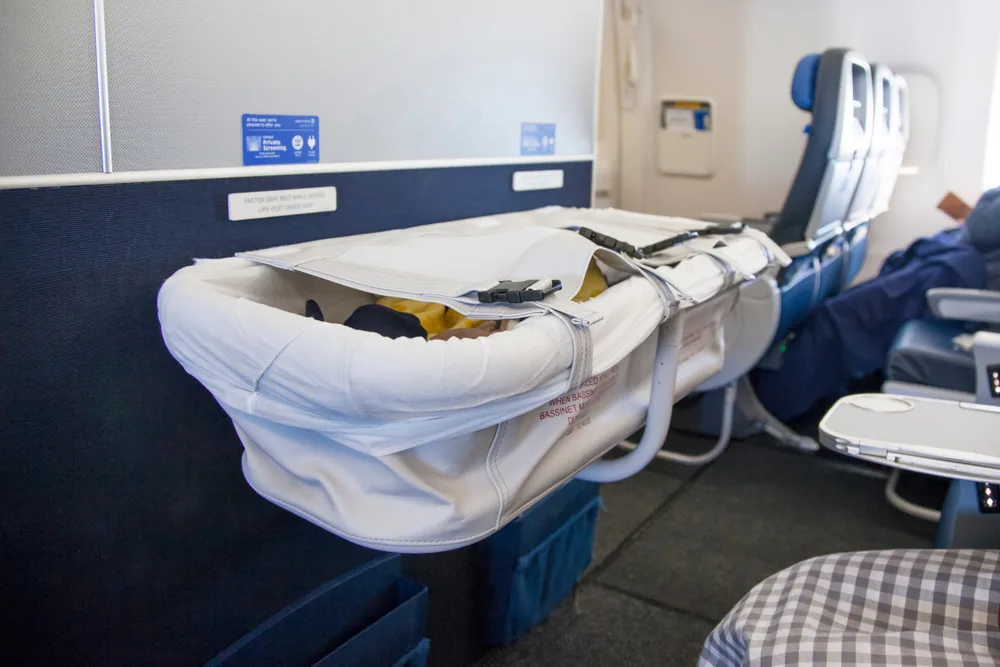
y_seki/Shutterstock
- Can offer more legroom
- May feature curtain partition or footwell cutouts
- Easy seat accessibility
- May be close to restrooms/galley
- May offer bassinet mounting brackets for babies
Many times, bulkhead seats offer more legroom than traditional plane seats where there are reclining seats in front of you. With no one reclining into your leg space and no seat in front of you, you’ll find bulkhead seats to be roomier.
That’s especially true if you’re flying on a plane that has a bulkhead curtain partition, which provides even more legroom for stretching out, instead of a true wall.
You might get lucky and end up on a plane that has bulkhead footwell cutouts that include extra legroom for passengers in their design. Recline and stretch your legs all the way out without being limited by the wall!
That makes bulkhead seats a great place to sit if you’re hoping to catch some shuteye on a long flight.
Seats in the bulkhead are easy to access and make getting in and out of your seat pretty seamless. Leaving and returning to your seat is much easier without a row of seats in front of you.
Add to that the fact that bulkhead seats are often conveniently located near the restrooms or galley of the plane – it’s simple and quick to get to the facilities when you need to use them.
If you’re a parent or guardian traveling with a baby, you’ll find that bulkhead seats can be extra helpful because many airlines feature bassinet mounting brackets on the bulkhead itself.
That means you can safely tuck your infant into a comfy (airline-provided) bassinet and monitor them without physically holding them for the duration of the flight. It’s more comfortable for you and baby.
Read Next: The Safety of Air Travel Is Improving. Here’s Why
Bulkhead Seat Cons
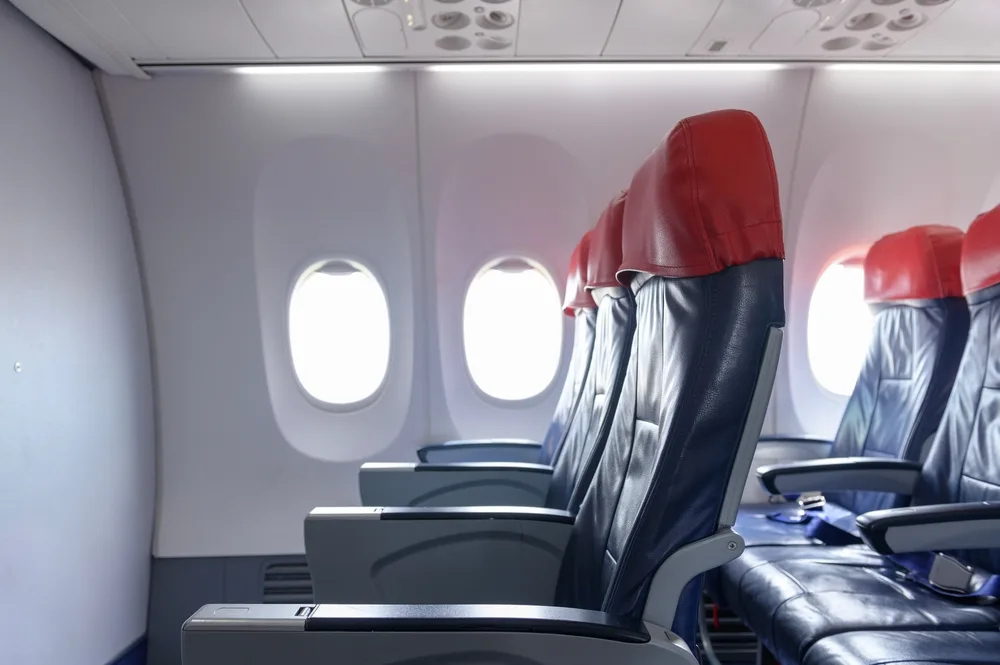
Thanakorn.P/Shutterstock
- No under-seat storage
- Legroom may be limited
- Awkward screen viewing angles
- Flimsy armrest trays
- Close to restrooms and galley
- POC users may not be able to sit here
- Can be more expensive
There’s no under-seat storage in bulkhead seats because there’s no row of seats in front of you. Without a special space to put your personal item or carry-on bag, it’ll have to go in the overhead bin or take up more of your legroom.
Since FAA rules require your personal item and/or carry-on bag to be safely stowed in the overhead bin during takeoff and landing when you’re in the bulkhead row, that can be a real issue.
If you need access to your personal item or carry-on bag throughout the flight, you’ll have to either hold onto it or continually get to the bin to retrieve and replace items. Talk about inconvenient!
While bulkhead seats are often touted for their extra legroom, the opposite can actually be true on some flights. Bulkhead walls without footwell cutouts can restrict your ability to stretch your legs out during the flight.
There’s also the issue of further-restricted legroom if you settle into an aisle seat in the bulkhead. The aisle itself may curve into your space and require you to shift each time a crew member or passenger walks past.
In-flight entertainment and flip-down trays are expected features on a flight, but in the bulkhead, these amenities are a little different.
Your display screen may be fixed high up on the bulkhead wall or offered in a swing-out design from the armrest. Either way, you’ll have to crane your neck to view it.
Instead of the usual flip-down trays from the seat in front of you, bulkhead seats offer flip-out trays from your armrest. They’re a little flimsier and take up more space in your lap than the flip-down style.
Another issue with bulkhead seats is sometimes both a blessing and a curse – the proximity to the restrooms and galley.
It’s convenient to access them, but a constant stream of people waiting for the restroom, crew members crowding up during service, noisy conditions if you’re trying to sleep, and unpleasant odors can make this a real problem for bulkhead passengers.
Delta Air Lines, American Airlines, Virgin Atlantic, and other airlines don’t allow passengers using POCs – portable oxygen concentrators – to sit in bulkhead seating due to the lack of under-seat storage during takeoff and landing.
Finally, bulkhead seats are usually more expensive than other seat selections on a flight. This is usually the case for planes that offer footwell cutouts and extra legroom in the bulkhead row.
Should You Choose a Bulkhead Seat?
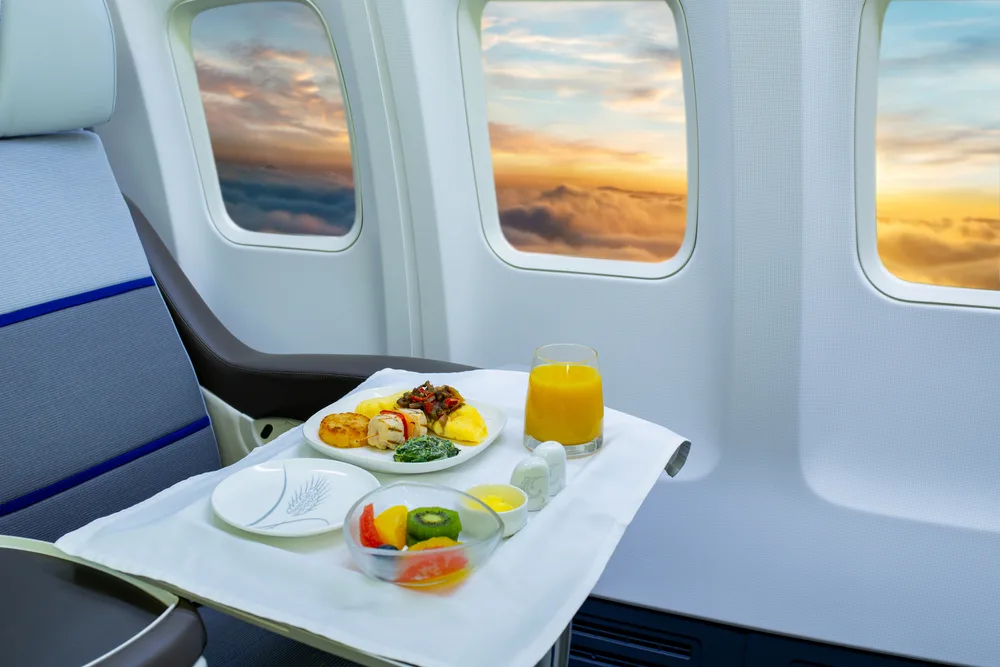
Aureliy/Shutterstock
You’ve seen the pros and cons, so what’s the word on this type of seat selection – is it worth choosing a bulkhead seat?
It can be great for some passengers traveling in first or business class and a nightmare for others. You might appreciate bulkhead seats in the following scenarios.
If you know you’ll be using the restroom often during your flight – especially on a long-haul flight – it can be a good idea to choose bulkhead seats so you don’t have to squeeze in and out of a row with seats in front of you.
If you’re a parent, bulkhead seats can be a great option with their proximity to the restrooms, galley, and added bonus of bassinet mounting brackets (if you have an infant).
If you’re very tall or have trouble getting in and out of a traditional seat when squeezed between rows, bulkhead seating with a curtain partition or footwell cutouts can be ideal, though more expensive.
And if you’re planning on flying first class or business class, you’re more likely to appreciate bulkhead seats because they may have footwell cutouts or extra-roomy space around them.
Bulkhead seats can be a major issue in some cases, however. Here’s when you should avoid them.
If you’ll be working during the flight, bulkhead seats lack dedicated storage space for your personal item (like a laptop bag) or carry-on bag.
That requires you to stow your laptop or briefcase in the overhead bin during takeoff and landing – and you’ll be lucky if you snag some space that’s actually near your seat.
During the flight, the only spot for your bag will be in your lap or at your feet, further restricting your legroom while you’re trying to work.
If you’re the type of passenger who prefers to wait until the last minute to board to spend as little time on the plane as possible, finding open overhead bin space near your bulkhead seat can be a nightmare.
That’s not even counting the additional noise, odors, and crowds of people (crew and passengers) that stream past the bulkhead area on their way to the restrooms and galley.
Things to Consider
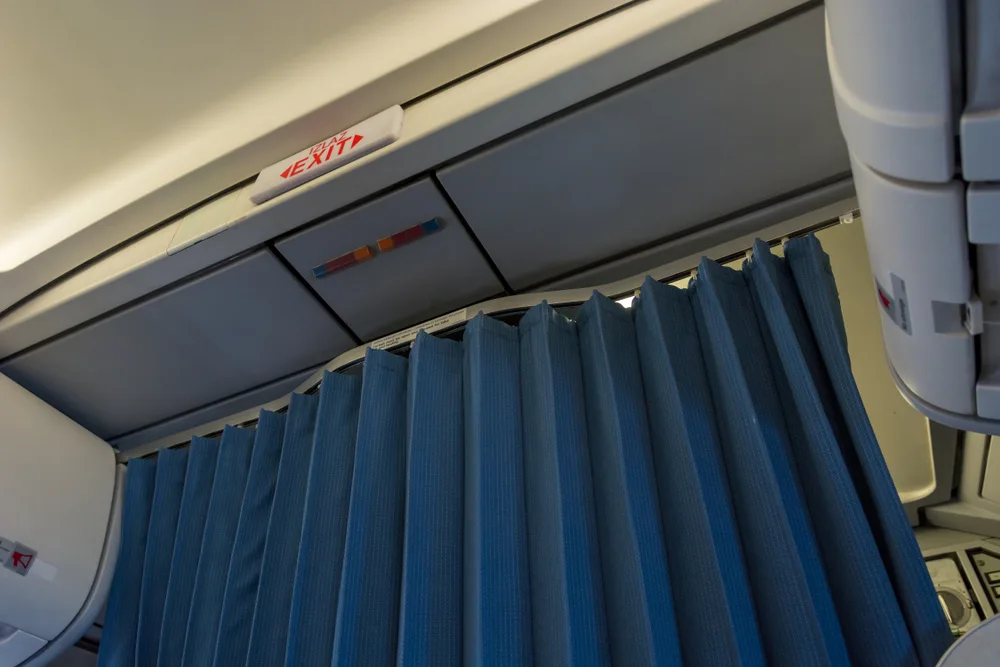
Bizi88/Shutterstock
What else should you know about bulkhead seats and making sure you’re choosing a good spot on the plane? Here are some helpful air travel tips to keep in mind.
- Use AeroLOPA to check out bulkhead seats. Different planes have different features and layouts. Use a site like AeroLOPA to research! Simple color-coding and diagrams help you pinpoint the best seats with more legroom and special features so you’ll never end up in a terrible seat.
- Board the plane early. While it can be a good idea to board the plane later if you hate sitting on the aircraft for a while before takeoff, boarding early is a good idea if you’re sitting in a bulkhead seat. That’s because you’ll need overhead bin space near your seat for your personal item or carry-on bag with no under-seat storage in these areas. Board early, snag your bin space, and settle in for your flight.
- Learn how to land a great seat on the plane. From reserving your seat early to knowing how to ask for a seat upgrade, it’s possible to snag a great seat without necessarily paying extra.
- Reserve a bassinet for infants ASAP. If the reason you’re thinking about going with a bulkhead seat is to secure a bassinet for your baby, you’ll want to reserve it ASAP. With some airlines, you can reserve it as soon as you book your flight. With others, you may have to wait until check-in. If you weren’t able to reserve one, you can ask a crew member – there’s a chance you could get bumped up to the bulkhead row or seats with bassinet mounting brackets.
- Bring fewer personal items. If you’re sitting in a bulkhead seat, keeping personal items with you in your seat will only take up more room (and they have to be stored in the overhead bin during takeoff and landing). Consider putting your stuff into a carry-on and only keeping a small tote at your seat to maximize your lap and leg space during the flight.
Frequently Asked Questions

Yaroslav Astakhov/Shutterstock
We started with the simplest question: What is a bulkhead seat? Now, let’s take a look at some of the additional concerns and questions travelers have about this seating section.
Is it good to sit at the bulkhead in a plane?
Sometimes, it’s good to sit at the bulkhead on a plane - it’s convenient to the bathrooms, may offer extra legroom, prevents passengers from reclining back into your space, and has special features for parents of infants traveling in bassinets.
But sitting at the bulkhead on a plane can also present issues that other plane seats don’t have, like potentially restricted legroom with some plane designs, no under-seat storage, and noise, odors, and traffic to the restrooms and galley.
What are the disadvantages of bulkhead seating?
The disadvantages of bulkhead seating include limited legroom in planes with physical wall partitions and no footwell cutouts, a lack of storage under your seat, a higher price, and awkward placement of display screens and flip-out trays.
Having to place your personal item or carry-on in the overhead bin instead of under your seat is inconvenient, and the close proximity to restrooms and the galley means it can be loud, smelly, and crowded near your seat.
What are the benefits of bulkhead seats?
Bulkhead seat benefits include the potential for more legroom (in planes with curtain bulkheads or footwell cutouts), mounting brackets for infant bassinets, no passengers reclining in front of you, and easy access to restrooms and the galley.
It’s easy to get in and out of your seat without a row in front and can be a good spot to sleep on longer flights if you have plenty of legroom.
What is the bulkhead seat position?
Bulkhead seats are positioned throughout large planes, always located behind bulkheads - walls or curtain partitions - that divide cabin classes and sections of the plane.
Bulkhead seats are the first row of seats in a section with no seats in front. A small plane may have one bulkhead while a large plane may have multiple.
Do bulkhead seats recline?
Bulkhead seats do recline, but on some planes, the seats may not fully recline like seats in rows further back.
The advantage of bulkhead seats isn’t the degree of recline, but the lack of passengers reclining into your leg space with no seats in front.
Should You Book a Bulkhead Seat?
Is the bulkhead seat something you should avoid at all costs or seek out when it’s time to choose your seat?
The answer is usually “avoid at all costs” due to the restricted legroom and storage space, proximity to the restrooms and galley, and awkward tray and display screen placements.
But there are a few cases where bulkhead seats can be the best option, like for parents with infants and young children, people who need the restrooms often, and on planes with bulkhead curtain partitions or special footwell cutouts that provide extra legroom.
Only you can decide whether or not a bulkhead seat is a good option for you. In general, it’s best to avoid the bulkhead unless you have a specific need or it’s the only seat left on the flight.



